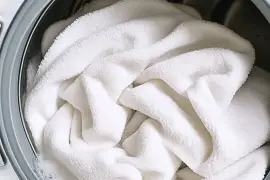
How to Clean Pillows by Hand: A Simple Guide for Fresh, Fluffy Comfort
When was the last time you cleaned your pillows? Most of us overlook this crucial step in keeping our beds fresh and hygienic. Surprisingly, pillows can harbor sweat, oils, dust mites, and even bacteria over time. But don’t worry—cleaning them by hand is easier than you might think.
Here’s a surprising tip to get you started: Adding a few drops of your favorite essential oil during the rinse will leave your pillows not just clean but smelling divine—a little secret to elevate your bedtime comfort!
Ready to dive in? Let’s give your pillows a new lease of life with this step-by-step guide.
Step 1: Check the Care Label
Before anything, check the care label on your pillow. Most synthetic, down, or feather pillows or cleaning a bamboo pillow can be hand washed, but memory foam pillows typically need spot cleaning. A quick glance will also tell you the dos and don’ts for your specific pillow type.
Step 2: Gather Your Cleaning Supplies
Here’s what you’ll need:
- Warm water (not too hot to avoid damaging delicate fillings)
- Mild liquid detergent
- Baking soda (for stubborn odors)
- White vinegar (for natural deodorizing)
- Essential oils (optional, for that luxurious scent)
- A large tub or sink
- A gentle scrubbing brush or sponge
Step 3: Pre-Treat Stains
Got yellowed spots from sweat or makeup? Pre-treat these areas with a mix of baking soda and water. Gently rub the paste into the stains using a soft brush. Let it sit for 10 minutes before washing.
Step 4: Wash Your Pillow
- Fill your tub or sink with warm water and add a small amount of liquid detergent. Swish it around to create suds.
- Submerge the pillow fully, squeezing it gently to allow the soapy water to penetrate.
- Avoid wringing or twisting the pillow—this can damage its shape and filling.
Step 5: Rinse Thoroughly
Empty the soapy water and refill the tub with clean, warm water. Add a splash of white vinegar to help remove any detergent residue and neutralise odors. Rinse the pillow thoroughly, squeezing it gently until the water runs clear.
Hook tip in action: Add 3–4 drops of lavender or eucalyptus essential oil to the rinse water. Not only will it leave your pillow fresh, but it can also promote better sleep.
Step 6: Remove Excess Water
After rinsing, gently press the pillow between two clean towels to remove excess water. Never wring the pillow, as this can cause clumping or damage to the filling.
Step 7: Drying Your Pillow
Proper drying is key to preventing mildew:
- Lay the pillow flat on a clean, dry towel in a well-ventilated area.
- Flip it regularly to ensure even drying.
- For feather or down pillows, give them a gentle fluff occasionally to maintain their shape.
Step 8: Revive the Fluff
Once dry, give your pillow a good shake and fluff it up. For extra fluffiness, pop it in the dryer on a no-heat cycle with a couple of clean tennis balls. This trick works wonders for feather and down pillows.
Step 9: Maintain Between Washes
To keep your pillows fresher for longer:
- Use pillow protectors to shield against sweat and spills.
- Air your pillows in the sun every couple of months. UV rays naturally kill bacteria and mites.
- Spot clean small stains immediately to prevent them from setting.
Step 10: Know When to Replace
Even with proper care, pillows don’t last forever. If yours is losing its shape, causing neck discomfort, or looking permanently yellowed, it might be time for a new one. A general rule? Replace your pillows every 1–2 years.

Cleaning Pillows with Hydrogen Peroxide
For pillows with stubborn stains, such as yellowing from sweat or drool, hydrogen peroxide can be a game-changer. This natural bleaching agent works wonders on organic stains without the harshness of traditional bleach.
To clean your pillow, mix a solution of one part hydrogen peroxide with two parts warm water. Dab the mixture onto the stained areas using a clean cloth or sponge, and let it sit for about 10–15 minutes. Afterward, rinse the pillow thoroughly with clean water to remove any residue.
Be sure to test the solution on a small, inconspicuous area first to ensure it won’t damage the fabric or filling. This method is particularly effective for white or light-colored pillows, restoring them to their original brightness.
Conclusion
Hand washing your pillows may seem like a chore, but it’s well worth the effort. Not only will you enjoy fresher, fluffier pillows, but you’ll also extend their life and ensure a healthier sleeping environment. So, roll up your sleeves and get started—your bed will thank you!
Remember, a clean pillow isn’t just about comfort; it’s about self-care. Now that you know how to clean pillows by hand, why not share this little-known essential oil hack with friends and family? Sweet dreams!

Related Article: How to Wash Pillows in a Top Loading Washing Machine





Comments are closed.